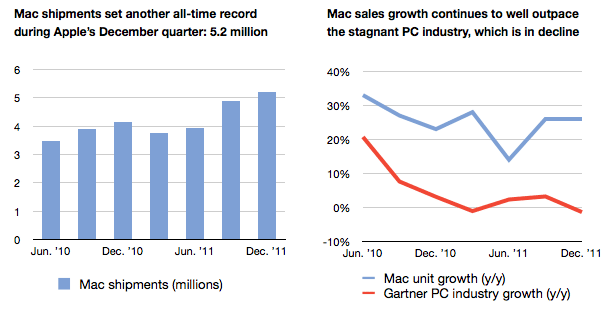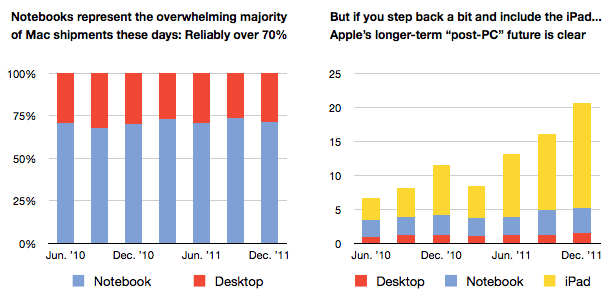It is reasonable to question the long-term future of Apple’s 28-year-old Mac business.

While the Mac set another all-time sales record last quarter, and is still growing, iOS is now clearly Apple’s most important platform. Apple also continues to re-shape the Mac experience in the iOS vision, leading some to speculate that future Macs will simply run a converged OS.
But in reality, the Mac isn’t going anywhere. It may not be growing as quickly as the rest of Apple, but it’s still a crucial part of the Apple story, and will be for at least another decade – if not much longer.
The Mac Business In Context

Apple sold a record 5.2 million Macs last quarter, generating $6.6 billion in revenue. But as Apple’s iPhone and iPad businesses grow like weeds, the Mac is chipping in less of Apple’s growth.
- The Mac represented 14% of Apple’s overall sales last quarter, down from 28% during the Dec. 2009 quarter.
- The growth in Apple’s Mac business represented just 9% of Apple’s overall revenue growth last year. (The iPhone represented 60%.)
- Apple sold almost three times as many iPads as Macs last quarter.
- And as Asymco’s Horace Dediu points out, Apple sold more iOS gadgets last year alone than it has sold Macs, all-time, ever.
Even within Apple, “Employees associated primarily with the Macintosh, once the cocks of the roost, were considered second-rate in the Apple hierarchy,” Adam Lashinsky writes in his new book, “Inside Apple,” via this excerpt from Fortune.
But in the context of its industry, the Mac continues to do very well.
- Its 26% year-over-year growth in unit shipments last quarter far surpassed the overall PC industry, which declined 1.4% year-over-year, according to Gartner.
- Apple has now grown faster than the overall PC market for 23 straight quarters.
- And its U.S. market share reached 11.6% last quarter, up from 7.5% in the Dec. 2009 quarter, according to Gartner. (Its global market share is still less than 6%.)
- Apple doesn’t break out the Mac business’s earnings, but it’s believed to be quite profitable.
Perhaps the worst thing the Mac has going for it these days is that it’s part of Apple, and has to be compared to the iPhone and iPad!
The Mac In A Post-PC World

If you were to imagine the personal computer that most people in the world would be using in, say, 2025, it would probably look more like an iPad than a Mac: Touch-based, simple, relatively inexpensive, lightweight, etc. So it makes sense that Apple CEO Tim Cook would predict that the tablet market will eventually become bigger than the PC market – that’s not just rhetoric.
But it’s also obvious that the tablet isn’t just going to replace the notebook or desktop computer for everyone in the foreseeable future. There are too many applications and situations to list where someone would be better served (or only served) by using a “PC” as we know it, and not a tablet. (For instance, without Macs, how would we make iPad apps? And how would Apple even design future iPads?)
So if people are going to buy PCs – especially high-end, premium PCs – why wouldn’t Apple want to continue to own that business? Of course it will!
In other words, the Mac isn’t going anywhere. Will it last another 28 years? No one knows that. But it should at least be around for another 10 years and probably 20.
What Should Apple Do?
So far, it’s on the right path.
It makes sense to continue to make the iOS and Mac user experience more similar, so that iPad and iPhone owners can easily jump to the Mac, and the other way around. Even if Apple’s goal is for iOS devices to operate independently from Macs, it’s also likely one of Apple’s goals to sell every iPhone or iPad buyer a MacBook Air.
It also makes sense to align the platforms around iCloud, so that people using either or both can have a more synchronized, unified experience.
But as long as Mac notebooks and desktops continue to use trackpads and mice, and not touchscreens, you can expect significant differences in the actual operating system. With different limitations on battery life and processing power, and different application needs, the iPad and iPhone call for more optimization, while the Mac calls for more sophistication and complexity.
Formally combining the two into one actual OS or platform doesn’t seem to be a near-term project for Apple. Bridging them together seems to be the plan.
Also: When Will Apple Peak?










